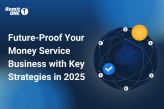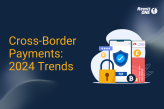Top 5 takeaways from the RemitONE Compliance for Money Transfers panel at IMTC EMEA 2021 November 23, 2021

Earlier in the year, a few of the key players in the remittance industry digitally gathered together to discuss a wide range of key topics within the field of money transfer compliance in a panel hosted by RemitONE. The panel included deep dives into anti-money laundering practices, responding to suspicious activity, OFAC compliance (Office of Foreign Assets Control), and much more.
Moderator:
Oussama Kseibati, Head of Services at RemitONE
Panellists:
- Ibrahim Muhammad, Independent Payments Consultant, Al Fardan
- Nadeem Qureshi, CTO, USI Money
To condense the panel into a few paragraphs would be a tricky task indeed, so we’ve decided to focus on five of the key takeaways that our panellists settled on during their discussion.
1. Cybercrime requires a threefold solution – Ibrahim
There are two different types of financial crime. Broadly speaking, on one hand, there are crimes related to money laundering, terrorist financing, fraud and cybercrime. On the other hand, there is financial crime related to bribery and corruption. When it comes to the money service sector it’s the former type of crime that’s been on the rise recently, thanks to the pandemic and the increased digitisation of companies.
How do we prevent these attacks? It’s a threefold solution. First, companies need to ensure the right people are in charge of their systems – this means people with a clear understanding of risk assessment. Second, they need to put well-documented processes in place, guided by policies and procedures. And finally, the systems need to be robust enough to identify, prevent and deter financial crime.
2. Plugins have made all the difference – Nadeem
The availability of plugins is gradually taking us away from an environment of weekly updates and into a more active, real-time environment. What used to take weeks can now take place in the space of days or even hours, with lists being updated and names being added constantly.
Working with something which is real-time means it’s so much easier to identify a weakness faster. These days you have customers registering and processing within a matter of minutes. But as we’re working towards that more efficient way of processing, it’s vital that the system is robust and is set to your needs as opposed to the system needs.
3. There are two sides to the story – Oussama
There are two main sides to the new compliance regulations that we’re seeing. It’s not just where you yourself operate, it might also be where and whom you’re sending to. What kind of regulations do they have and what are their maximum receive amounts, for example?
We have to understand this because there’s an ever-changing landscape right now with new rules and regulations being set all the time. Unless you’re on top of those changes, then you’re always going to be putting yourself at risk when partnering with someone. It’s also worth noting that a lot of the regulations come from the central banks and they will have their own lists and connections that you’ll need to take into account.
4. Transaction monitoring and risk profiling are key – Ibrahim
Transaction monitoring is a key part of KYC and should always be an ongoing process. When we onboard the customer, that doesn’t necessarily mean we’ve 100% verified them. It’s the ongoing transactional behaviour of the customer that allows us to do that and this is where profiling plays such an important role.
You need to do a proper risk profile or categorisation based on the transactional behaviour of your customers and categorise these customers into different risk profiles at both the customer level and the transactional level. Of course, there are multiple systems, including RemitONE’s, that can facilitate the onboarding process and ensure that the customers are who they claim to be. But they can also track where money is going so that, for example, if the destination country is high-risk then additional checks can be put in place and appropriate limits can be set.
5. Creating an effective monitoring programme is all about asking the right questions – Nadeem
The first thing to do when building a transaction monitoring programme is to really look at whether you’re a B2B, B2C or B2B2C service. Once you can answer that question and are able to identify your customers, it’s much easier to break everything down. After this, you need to answer the question of the dual jurisdiction process – the rules and regulations in the sending and receiving countries.
Finally, once the system is configured, you need to ask whether or not it needs to be looked at a little deeper. Because so often you’ll rush to go live and there will be a tech anomaly that was overlooked or a parameter that wasn’t set right. Once you can confidently answer all of these questions, only then can you create something in terms of a robust framework, whether it’s for monitoring or compliance.
We’d like to extend a huge thanks to Ibrahim, Nadeem and Oussama for their time and insights.
What next?
Now that you’ve read our article we want to help you get the most out of it and deep dive into the trends and predictions shared.
Tap into our experts and schedule a free 30min consultation.
Related Posts
-

How to Build a Leaner, Smarter Money Service Business in 2025
In an era of rapid regulatory change, rising customer expectations, and digital disruption, how can money service businesses (MSBs)—companies that…
May 22, 2025 -

Trump’s Threats to Cross-Border Payments: What It Means for Your Business
It’s been a short while since Trump stormed back into office, and he’s already shaken things up with his hard-hitting…
May 22, 2025 -

Unlock Faster, More Secure Payments with RemitONE’s Open Banking Solution
We’re excited to introduce the latest enhancement to our RemitONE Money Transfer Platform: the RemitONE Open Banking Solution. Competitively priced…
January 31, 2025 -

How to Expand Your SEND Operations in the UK and Europe—Without the Regulatory Hassle
The remittance market in Europe is valued at €133.7 billion annually, with the UK market contributing an additional £23 billion.
January 31, 2025 -

The Top 5 Cross-Border Payment Trends That Shaped 2024
What a year it’s been for the world of payments! From breakthroughs in tech to surprising shifts in consumer behaviour,…
December 19, 2024 -

How Banks Can Reclaim Their Role in Cross-Border Payments with RemitONE
Banks, once the cornerstone of international payments, are finding themselves sidelined. Senders and receivers have now joined forces, pushing banks…
December 18, 2024